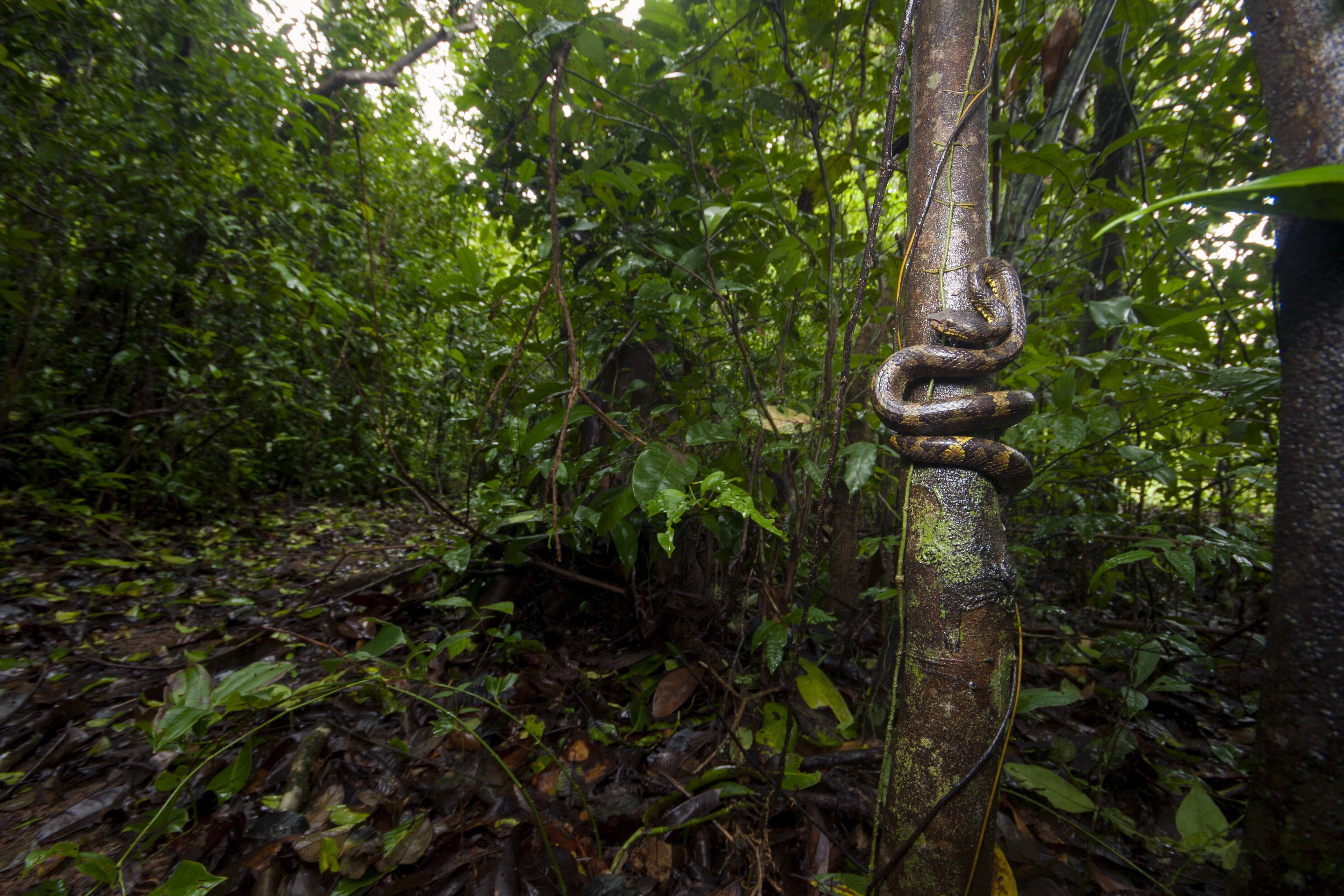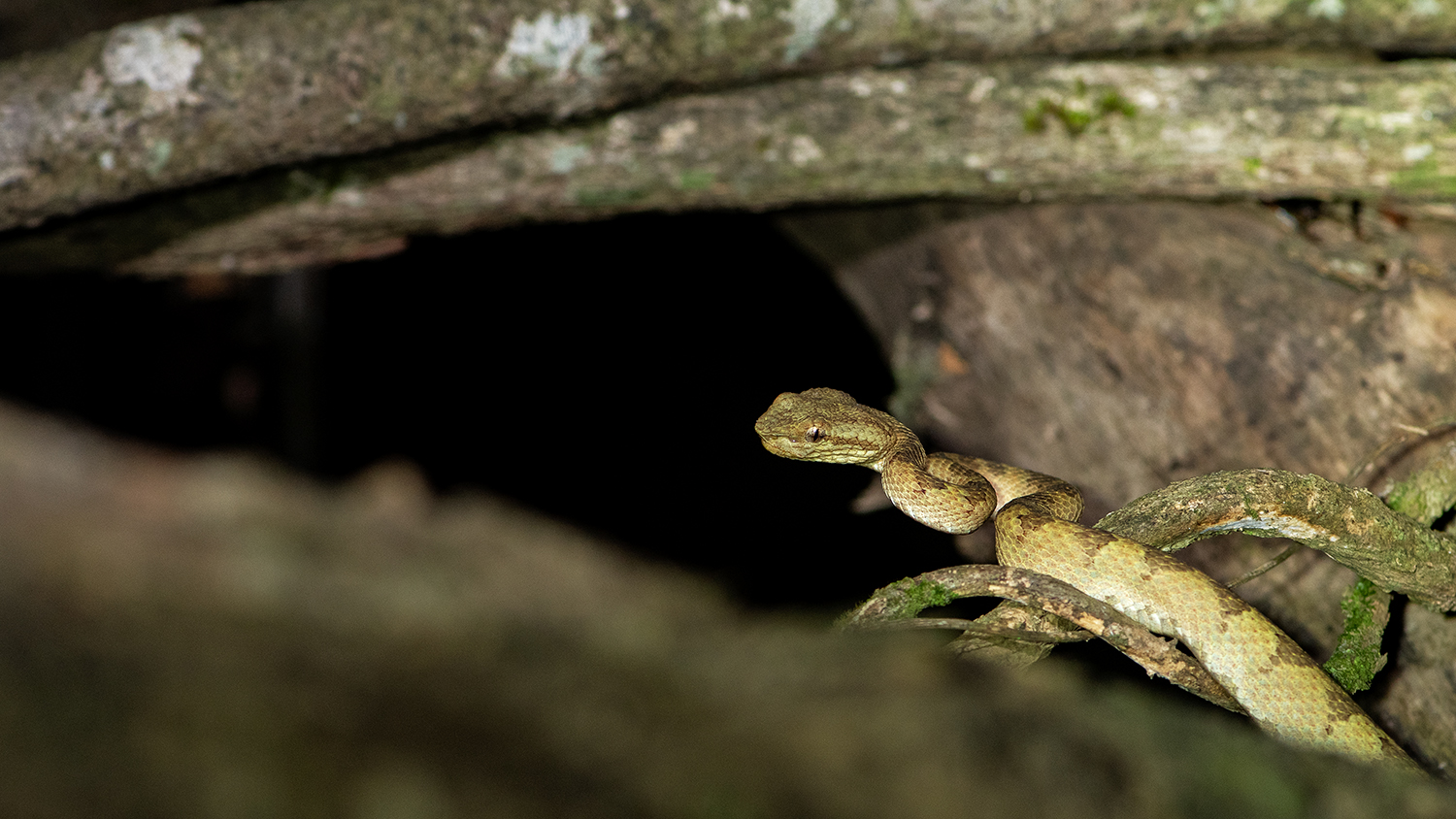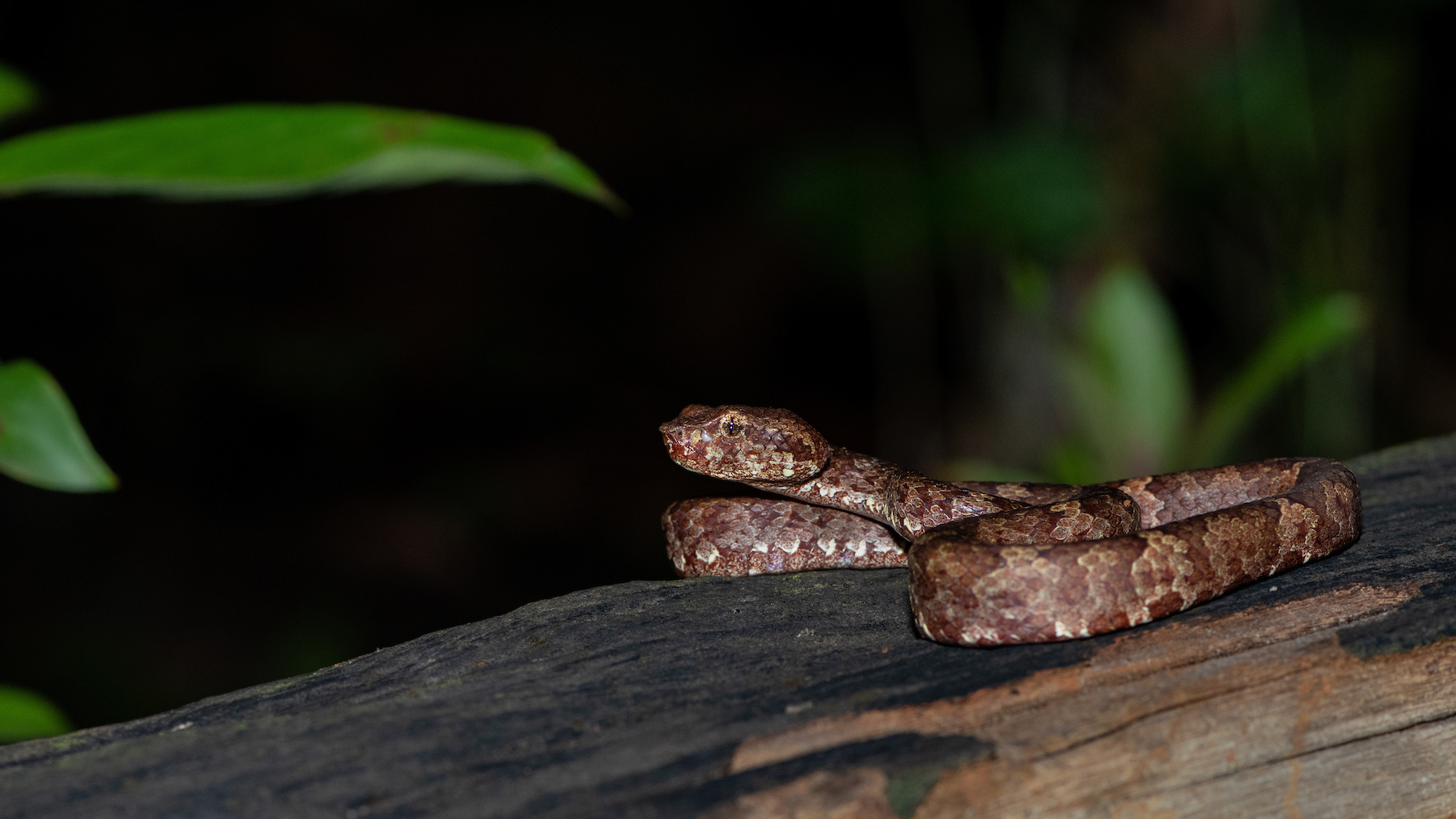“The triangular head, heat-sensing pits, and dorsal markings make them perfect subjects,” says wildlife photographer MV Shreeram, as we observe a Malabar pit viper on a log above an abandoned well, near the Kalinga Centre for Rainforest Ecology (KCRE) in Agumbe. The young snake, with patches of black on a turquoise green body, was ready to pounce on its prey. Shreeram then pointed out, to the group of photographers that he was leading on a night walk, a larger individual. This one was in a crevasse under the log, ready to employ a Malabar pit viper’s typical hunting strategy: ambush. The calls of frogs and crickets all around indicated that the pair had chosen a spot with plenty of easy quarry. Little did I know then that I would encounter the same two individuals repeatedly over the next few days of my stay in Agumbe.

The Malabar pit viper is a nocturnal snake. During the day it can often be seen at eye level resting on trees and rocks, near streams or in dense rainforests. Photo: Saurabh Sawant Cover photo: Malabar pit vipers are known to occupy the same location for days as they hunt for prey. This individual was spotted on the same log multiple times during the span of a week in Agumbe. Photo: Shreeram MV
Endemic to the Western Ghats, Malabar pit vipers (Trimeresurus malabaricus) are nocturnal snakes that are very much at home in the dense wet rainforests of Agumbe. They can sometimes be seen basking on rocks and trees near streams during the day. Like other vipers, Malabar pit vipers don’t lay eggs, instead they give birth to live young, around four to five babies at a time. These newborn snakes are able to kill prey and fend for themselves almost immediately.
Staying in one place for a long time while waiting for prey is an evolutionary mechanism used by a lot of ambush predators. I learned this from herpetologist Gerry Martin over a phone conversation a few days later. “They don’t expend energy unless they have to,” he said. “These snakes usually gorge themselves during the monsoon, when there are a lot of frogs about. They don’t need to feed often because they don’t move around so much. If a large pit viper gets a small mouse, that should last for a couple of weeks easily,” he continued.
As we walked back to the Centre, more surprises lay in store. We came across a mottled brown Malabar pit viper. The colour difference between the pair we had seen earlier, and this medium-sized individual was striking. Though Malabar pit vipers are known to occur in various shades from green, to brown, yellow, orange, brownish-red, and even violet, Shreeram, a frequent visitor to Agumbe, says the ones he’s most commonly seen here are the green and brown morphs.

Not enough studies have been done on these snakes to explain the reason behind their colour variations, but scientists believe it could be related to the snake’s age, or the humidity and temperature of their specific environment. Photo: Shreeram MV
Shreeram has an uncanny knack of spotting snakes in the dark. He also pointed out a yellow morph, which had hidden itself in the thick vegetation. It had been an eventful walk. Spotting three differently coloured Malabar pit vipers in one night was quite a feat, even by Agumbe standards.
“The scientific reason behind these morphs hasn’t been established yet. It could well be different stages in their lives. Almost all of them are born brown. And they exhibit sexual dimorphism as well. So, males are differently coloured and sized from the females. But no one has studied these snakes extensively enough to explain these colour variations,” according to Gerry.

A brown morph of the Malabar pit viper. This snake’s willingness to remain still, and its colour and markings make it an ideal and photogenic subject. Photo: Shreeram MV
During the next few days I sauntered off to the well at different times of the day to look for the familiar pair of serpents at the well. And sure enough, one of them would invariably be hanging around — on the log, inside the well, or on a nearby tree.
After a heavy spell of rain one evening, the forest chorus multiplied to a dense orchestra. Prashanth, the manager at KCRE, was visibly excited as he led a group of us along the path to the well. We could see frogs everywhere around us and sensed that the predators of the night were in for a feast. Prashanth, who was walking a little ahead of us, suddenly waved at us and pointed towards the floor. “Malabar pit viper with a kill,” he exclaimed, as we picked up our pace towards him. A juvenile, brown pit viper, less than 20 cm long and draped around a fallen twig, had caught hold of a frog. Still alive, the frog was trying its best to escape, but the snake had a deadly hold over it in its jaws. We watched the venom take effect and the frog slowly become motionless, before leaving the snake alone to enjoy its hard-earned meal peacefully.
The Malabar pit viper is a study in stillness. It remains motionless, waiting for its prey for hours, even days. But when the time is right, it strikes with lightning speed.
As we approached the well, I was sure that the vipers I had been observing over the past few days would still be there. We directed the beam of our torches to the log over the well and saw a pair of mating Malabar gilding frogs. We scanned the nearby bushes and saw tree frogs calling out for mates. The only place left to look was the inside of the well. And sure enough, she was there, the larger Malabar pit viper, one of two I’d seen earlier. With her tail safely secured inside a hole along the side of the well, she was curled in her customary S-shaped position, waiting to pounce on anything that moved within striking range. Oblivious to the frogs absorbed in the process of creating new life on the log above her, her single-minded focus was on catching and ending the life of the nearest prey.
Soon we left the well, a pit of life and death, where much drama was sure to ensue over the monsoon months. Frogs, blissfully unaware of the two master ambush predators lurking in their midst, continued croaking into the night.